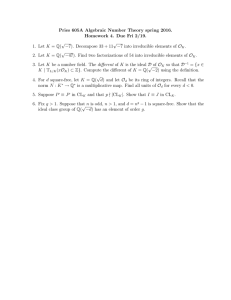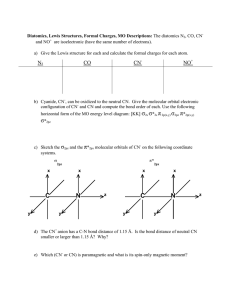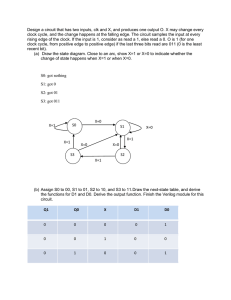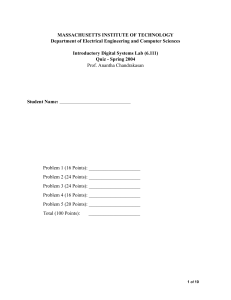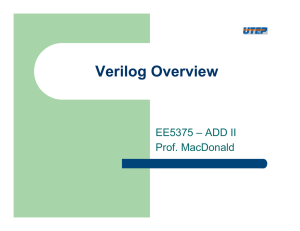Document 13515874
advertisement
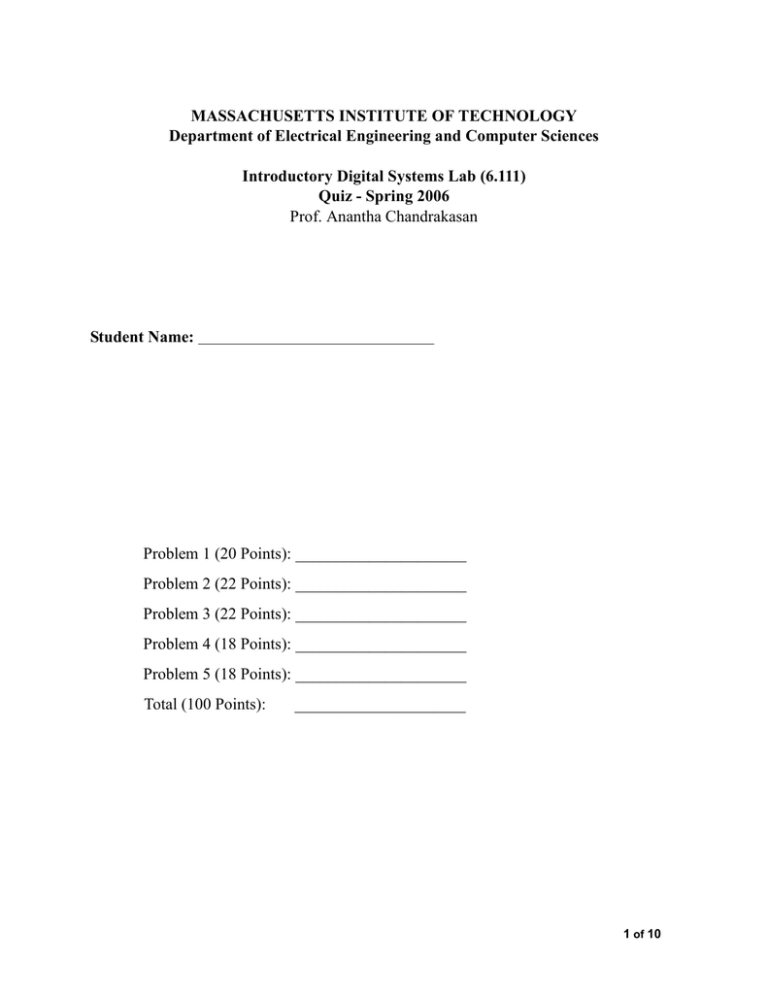
MASSACHUSETTS INSTITUTE OF TECHNOLOGY Department of Electrical Engineering and Computer Sciences Introductory Digital Systems Lab (6.111) Quiz - Spring 2006 Prof. Anantha Chandrakasan Student Name: Problem 1 (20 Points): _____________________ Problem 2 (22 Points): _____________________ Problem 3 (22 Points): _____________________ Problem 4 (18 Points): _____________________ Problem 5 (18 Points): _____________________ Total (100 Points): _____________________ 1 of 10 Problem 1: Sequential building blocks and counters (a) Consider the following sequential building block. (i) What type of sequential block is it? (ii) Assume that S = R = 1. What happens to the outputs Q and Q when CLK transitions from a 1 to 0? Briefly explain your answer. (6 points) Q Q S CLK R (b) Assume you have access to a D positive edge-triggered register. Construct a J-K positive edge triggered register that implements the functionality shown in the truth-table. Q+ is the next state. You may add logic gates as necessary (show a logic diagram). (6 points) J K Q+ 0 0 Q 0 1 0 1 0 1 1 1 Q J Q+ D Q Q K CLK 2 of 10 (c) Construct a 2-bit synchronous counter using the J-K register above (it should count 00J01J10J11J00...). Assume a black box for the J-K register with three inputs (J, K, CLK) and one output Q. A partial implementation is shown below. Minimize the number of additional gates required. Show the K-MAP optimization for the MSB.(8 points) J Q K Q1 CLK J Q K Q0 CLK 3 of 10 Problem 2: Carry Skip Adder: In this problem, we will explore the addition of two numbers based on the Carry Skip (or Carry Bypass) technique. (a) Consider the following 16-bit Carry Skip Adder (each + block represents a one full-bit adder). Assume the following delays: • Delay to produce the Pi, Gi signals from the Ai, Bi inputs is 1 (i.e., the delay of the PG block) • Delay to compute Cout,i from Pi, Gi and Cin,i inputs is 1 • Delay to compute Si from Cin,i, Pi, Gi being valid is 2 • Delay for the 2:1 multiplexor is 2 • Delay to compute the group propagate, GPi, once the propagates are available is 1 Cin,0 PG PG PG + + + + S0 S1 S2 S3 0 1 PG PG PG PG + + + + S4 S5 S6 S7 0 1 A8 B8 A9 B9 A10 B10 A11 B11 PG PG PG PG + + + + S8 S9 S10 S11 GP2= P8P9P10P11 PG A4 B4 A5 B5 A6 B6 A7 B7 GP1= P4P5P6P7 A0 B0 A1 B1 A2 B2 A3 B3 GP0= P0P1P2P3 Highlight the critical path for this 16-bit adder directly on the figure below (4 points) A12 B12 A13 B13 A14B14 A15 B15 PG PG PG PG Cout,15 0 1 + + + + S12 S13 S14 S15 A 16 bit Carry Skip Adder with a block size = 4. (b) What is the delay for a 32-bit adder assuming eight equal block sizes of 4 and making the same assumptions of delay as part 2 (a)? Assume that the last block does not have a multiplexor as in part 2 (a). (4 points) 4 of 10 (c) In the computation of group propagate signal (GPi) which involves the product of the propagate sig­ nals, the propagate for each bit should be computed as: (1) P = A + B (2) P = A ⊕ B (3) either P = A + B or P = A⊕ B Clearly explain your answer. (6 points) (d) Consider the following 32-bit adder variation where the block sizes of each stage are not equal. High­ light the critical path directly on the figure below. The figure shows a simplified diagram with some obvi­ ous details left out. What is the delay of the critical path? Assume the same delays as part (a). (8 points) A0,B0 A1-3,B1-3 A4-8,B4-8 PG PG PG + (0) 0 1 S0 + (1-3) S1-S3 0 1 + (4-8) S4-S8 1 + (9-15) S9-S15 0 1 + (16-22) S16-S22 A28-30,B28-30 A31,B31 PG PG PG 0 A23-27,B23-27 A16-22,B16-22 A9-15,B9-15 0 1 + (23-27) S23-S27 PG 0 1 PG + (28-30) 0 + (31) 1 S28-S30 S31 A 32-bit Carry Skip Adder with a variable block sizes. 5 of 10 PROBLEM 3: Glitches in Digital Design Assume for that for the entire problem the counter reset is synchronous. (a) Consider the one-second clock enable from lab2. The 1Hz enable is derived from the circuit below (the clock is the 27Mhz clock). Assume that a global reset signal puts the count to 0 (the circuit is not shown here). The 1Hz enable is used to clock other circuits that need to be updated once per second (e.g., the reg­ ister shown below). Identify the main problem with this circuit. (5 points) register 1Hz Enable In D Q Out Counter reset Count [24:0] Q Combinational 25 Logic (comparator) = CLK 25’d26999999 (b) Propose a solution (draw the logic diagram) that fixes the above problem, but implements the exact same functionality. The solution must be fully synchronous (i.e., a single clock to every register). (6 points) 6 of 10 (c) As discussed in class, a common architecture used in the design of Digital-to-Analog Converters is using binary weighted current sources. Assume that the two input bits (b1, b0) are output from registers but can arrive at the switches at different times (due to the variation in wire delays from the register to the switch). What is the LSB (in volts) and full scale swing of this DAC (you might want to sketch out the out­ put voltage vs. digital code word). Describe the key problem associated with this architecture. (5 points) VDD VDD I 2I b1 b1 b0 b0 + R vout - (d) Propose a solution that avoids the problem in part (c) and only uses unit sized current sources (I). Add the necessary gate-level logic required to implement the digital-to-analog conversion. (6 points) 7 of 10 PROBLEM 4: Memory (a) The 6264 memory in lab3 is a 8192 x 8 bit memory chip. Architect this memory at the block diagram level (include decoders, amplifier, wordline, etc.). Clearly indicate how many bits are at the input and out­ put of decoders. Assume each row stores 32, 8-bit words (i.e., 256 bits). Also include one line to describe each block. (14 points) Block Diagram: Provide a 1-line description of the functionality: Row Decoder: Column Decoder: Sense Amplifier: Wordline: Bitline: (b) What are two major differences between SRAM and DRAM? (4 points) 8 of 10 PROBLEM 5: Verilog (a) Complete the behavioral description in Verilog for a synchronous 74163 counter used in lab1. The basic template is shown below -- fill in the necessary code to complete the description. (8 points) module counter (LDbar, CLRbar, P, T, CLK, D, Q, RCO); input LDbar, CLRbar, P, T, CLK; input [3:0] D; output [3:0] Q; output RCO; reg [3:0] Q; always @ (posedge CLK) begin end assign RCO = endmodule (b) Complete the follow piece of code to implement a synchronizer (which includes two back to back reg­ isters) (4 points) input in; reg q1, q2; always @ (posedge clk) begin end 9 of 10 (c) The code below should implement a simple four state FSM which increments a 4-bit synchronous counter when the FSM is in state 2’b10. Identify the major problem with this code when synthesized. Pro­ pose a solution to fix the problem. You can define a new variable if necessary. (6 points) module simple_fsm(clk, reset, count); input reset, clk; output [3:0] count; reg [3:0] count; reg [1:0] state; reg [1:0] next; always @ (posedge clk) begin if (reset) state <= 2'b00; else state <= next; end always @ (state or reset or count) begin if (reset) count = 4'b0000; case (state) 2'b00: next = 2'b01; 2'b01: next = 2'b10; 2'b10: begin next = 2'b11; count = count +1; end 2'b11: next = 2'b00; default: next = 2’b00; endcase end //always endmodule 10 of 10

